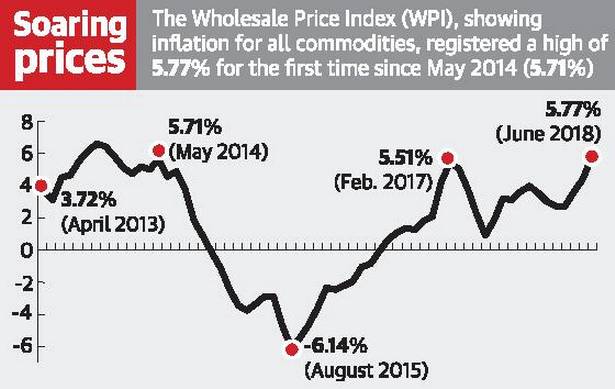What is the issue?
- The Wholesale Price Index (WPI) rose 5.77% on a year-on-year basis to a 54-month high in June 2018.
- The inflation scenario demands a closer look at the macro-economic conditions.
What are CPI and WPI?
- Both measure the inflationary trends i.e. movement of price signals within the broader economy.
- WPI tracks year-on-year wholesale inflation at the producer or factory gate level.
- It is a marker for price movements in the purchase of bulk inputs by traders.
- Consumer Price Index (CPI) tracks changes in prices levels at the shop end.
- It is thus reflective of the inflation experienced at the level of consumers.
- The two indices differ in the manner in which weightages are assigned.
- This applies to food, fuel and manufactured items as well as their sub-segments.
- E.g. weightage of food in CPI is far higher (46%) than in WPI (24%).
- Also, WPI does not capture changes in the prices of services but CPI does.
What are the driving factors for WPI rise?
- Rising crude oil prices has persistently driven inflation.
- Inflation in the fuel and power group has risen every month in the recent period.
- Food articles, especially vegetables, have been on a rising trend as well.
- The inflation in politically sensitive duo of potatoes and onions is a notable cause.
- Manufactured products (largest weight in the WPI) are also on an inflationary trend.
- WPI rise is also to be seen from the perspective of an unfavourable base effect.
- It is the effect of the previous year taken as the base for calculation.
- This is because the WPI inflation in June 2017 was just 0.9%.

Is WPI rise a concern?
- Policy - In 2014, RBI had adopted CPI as its key measure of inflation from the earlier WPI.
- India thus shifted to CPI as the benchmark for deciding policy rates (e.g. repo rate).
- Accordingly, RBI has a target to keep consumer-level inflation at 4% (+/- 2%).
- Any rise in CPI inflation beyond this comfort zone pressurises RBI to hike interest rates.
- So WPI rise might not appear relevant from a policy perspective.
- Economy - However, price changes at the producer level usually get transmitted to the consumers.
- But this could come with a time lag or may not be to the full extent of the impact at the producer level.
- So, the apprehensions with a higher WPI may not be valid at all times.
- Nevertheless, a steady rise in WPI is certainly an indicator of an overall inflationary pressure.
- It reflects the unbalanced conditions within the broader economy.
- Retail - There is a concern of a cascading effect of WPI increase on the CPI.
- This remains even after discounting for the base effect.
- Evidently, the retail inflation (CPI) had risen to a 5-month high of 5% in June, 2018.
How does it affect growth?
- Inflation-growth relationship is “significantly negative” if inflation is above a threshold value.
- It is “insignificant or significantly positive” if inflation is below the threshold value.
- Simply, inflation to a certain extent is favourable to the economy, above which it becomes harmful.
- But generally, the threshold values in developing countries are relatively higher.
- In India's case, roughly 4 to 5.5% inflation is said to be the range, above which it retards GDP growth rate.
- But substantial gains can be achieved if inflation is kept below the threshold.
How does the future look?
- Government has recently decided to increase the minimum support price for kharif crops.
- A possible inflationary pressure due to this exists already.
- On the other hand, inflationary trend has reinforced the expectations of a repo rate hike.
- As, rate hike would be a measure of controlling the inflationary trend.
- However, IMF in a recent update has said the Indian economy will grow slower than estimated earlier.
- It has also cut India’s growth projection for 2018-19 by 10 basis points to 7.3%.
- The pressure on growth due to the added impacts of inflation and faster interest rate hikes is the reason.
- Thus, balancing between inflation and growth prospects would be a challenging task for the policy makers in the near future.
Source: The Hindu, Indian Express
